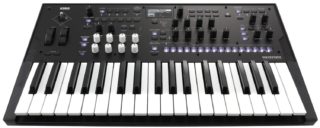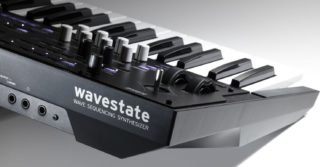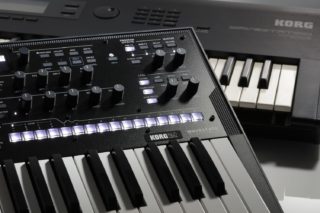Ahead of the 2020 NAMM Show, Korg has introduced the new Wavestate wave sequencing synthesizer.
The Wavestate is an updated take on Korg’s 90’s Wavestation, which featured wave sequencing and vector synthesis. They say the Wavestate is built from the ground up, though, “taking cues from sources as diverse as modular synths, groove boxes, and algorithmic composition.”
The Wavestate is also designed to be very tactile, with knobs and controllers for all the basics – giving envelopes, LFOs, and effects dedicated front-panel controls.
In addition, a front-panel button, marked by a “dice” icon, generates new sounds via intelligent randomization.
The Wavestate combines Korg’s Wavesequncing 2.0, deep modulation capabilities, plenty of polyphony (64 notes) and up to four parts and 14 effects simultaneously.
Though it has a compact form-factor, it features 37 full-size keys. Six GB of PCM delivers over 700 sounds and 240 performances, plus there are 1,000 Wavesequences to explore and storage for over 10,000 performances.
To help users get the most out of wavestate, eight hardware Mod Knobs provide musicians with instant access to key sound performance parameters.
Korg notes that the Wavestate was designed by their R&D department in San Diego, California, the same team that created the original Wavestation, co-created the OASYS and Kronos, and that developed fundamental technologies behind many other Korg instruments. They say that the Wavestate reflects their unique aesthetic, delivering stunning sound and deep flexibility via cutting-edge technologies.
Audio Demos:
Pricing and Availability
The Wavestate will be available in January of 2020 for $799.99














Sounds more like RaveStation from the video.
Is there a bigger keyboard? To me a 3 octave keyboard is either: monophonic, intended for people not really interested in playing more than one or two keys at a time, cost compromise between two models: keyboard less and 4+ octaves.
Yeah…
Does the keyboard have poly after-touch ?
Is the synth engine MPE -able ?
With 64-notes polyphony, 3 octaves is limited.
A desktop version would be better, to play with our 48-61-72-88 key controllers.
What I’ve seen, the keyboard has only velocity and release velocity, but the synth engine will respond to channel aftertouch an poly aftertouch.
Cool!
Yes!! Finally! So glad they did this!! Just wish it was 64 keys but who cares!!!!!!
It looks interesting, not sure about the sound. But – is it multi-timbral? It has 4 parts, but are these just layers in a sound or separate midi parts? With 64 voice polyphony and being all digital, multi-timbrality should be a no-brainer..
wow, korg is killin it. i need this in module form or VST….
If you want it in vst form … it was called Xphraze and was made by reFX but it is no longer available ….
This is a very exciting new synth! Have always been fascinated by the original Wavestation, but the complexity of the programming always put me off getting one. None of recent Korg products (Volcas and -logue lines) ever sparked any interest to me, but this definitely is!
FWIW, the iOS iWavestation app has all the 18 original ROM’s @ 50 presets/card – 900 presets have kept me from repairing my old Wavestation AD. I love the clinky-clunky sequenced timbres. And it’s very easy to edit now.
Oddly, the video reminds me more of the Radias.
Looks interesting!
I’ve always been intrigued by the Wavestation, but not at vintage prices.
Vintage prices???? They go for peanuts these days, in the US anyway.
Adjusting for inflation, they go for about 1/8 of the price now as they did when released. And even not adjust, less than 1/4 of that price. So now you know!
350-50 us dollars. Write me if interested.
There is an iOS version of the Wavestation (iWavestation) which is $30, and sometimes $20 when it’s on sale.
So that’s a more pocket friendly option.
No aftertouch for the keybed, but responds to channel and poly aftertouch (MPE capable I believe). And the keybed does have release velocity. Also note the polyphony is 64 stereo which is nice.
Hmm… Just to be clear: while channel/poly aftertouch may approach the polyphonic expression of MPE, MPE is a version of the MIDI (1.0) protocol for per-note expression which includes pitchbend and CC 74. It doesn’t sound like Korg has adopted this protocol for any of its sound engines.
I’m so glad that we are getting a new affordable digital synth.
I can only assume the meager 3-octave keyboard is because Korg is focusing more on the wave sequencing than vector for this synth. If your purpose is to use the Wavestate to add elements to a groove, 3 octaves should do fine, but I see a lot of potential for this synth to be a pad monster – and for that, we need no fewer than 5 octaves.
Honestly I think this synth would be better suited as a desktop module, perhaps with a row of pads or buttons for triggering wave sequences. Hopefully we’ll see a full-length keyboard or module version.
I remember Tony Banks playing the keyboard solo on the Genesis song Fading Lights using an original Korg Wavestation. See 4:36 through 7:34 in this clip:
https://www.youtube.com/watch?v=Ao34UhjV5ZM
Lovely unique concept!
… waiting for friday 10th tho 😉
Kind of wish this had two extra outputs- otherwise, from the videos I saw- it’s really like no other hardware out there…
I hope youre not telling me that Korg missed the ultimate wavestation trick with the remake? So NO CUSTOM PCM WAVEFORMS?!!
If so, the original wavestation with the WaveRex card is still a better option. The UI looks hella fun on the remake tho!
As a seasoned Wavestation user and owner (I had all of them, plus I use the amazing wave sequencing in the Kronos) I did not hear ANY signature wave-sequencing timbres in that demo. (?) Of course no one wants to hear that “Ski” something patch anymore but come on, put some effort into showcasing the technology!
I bought a Korg wavestation rack in 1992. That was awesome. I have seen the demo on youtube, heard the sound quality on my Bower and Wilkins speaker and Audiotechnica headphones, it just fantastic. I will simply buy it.